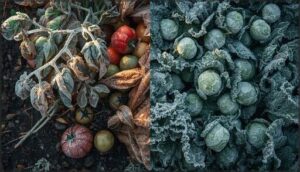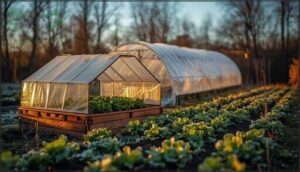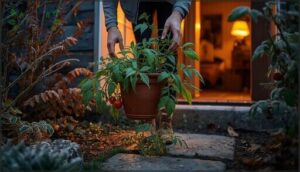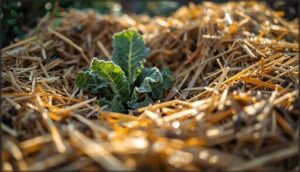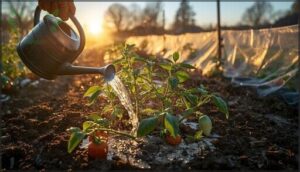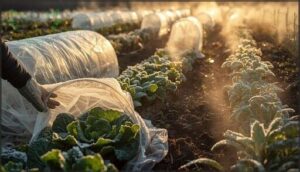This site is supported by our readers. We may earn a commission, at no cost to you, if you purchase through links.
A single unexpected frost can wipe out weeks of gardening work in a matter of hours. Tomatoes turn black and mushy, cucumber vines collapse, and bean plants wither overnight. For vegetable gardeners, frost isn’t just an inconvenience—it’s a threat that can destroy an entire season’s harvest if you’re not prepared.
The good news is that protecting vegetable gardens from frost doesn’t require expensive equipment or complex strategies. Understanding when frost will strike, which crops need protection, and how to shield your plants makes the difference between salvaging your harvest and starting over.
With the right techniques, you can extend your growing season by weeks or even months, keeping your garden productive well into fall and getting an earlier start in spring.
Table Of Contents
Key Takeaways
- You can extend your growing season by weeks or months if you understand your local frost dates, monitor weather forecasts closely, and recognize that factors like valley locations, high elevation, and clear skies significantly increase your frost risk.
- Tender vegetables like tomatoes, cucumbers, and beans die quickly when temperatures drop below 32°F, while hardy crops such as kale, spinach, and Brussels sprouts can tolerate hard frosts down to 25–28°F without damage.
- Protecting your garden doesn’t require expensive equipment—simple techniques like row covers, cold frames, mulch layers, and watering before a frost can raise temperatures by 2–8°F and cut frost damage by up to 50%.
- Smart garden design matters just as much as emergency protection, so place your beds on south-facing slopes, use raised beds that warm 3–5°C faster in spring, and position water barrels or stone pathways nearby to act as heat sinks during cold nights.
Determining Frost Risk in Your Garden
Before you can protect your garden, you need to know when frost is likely to strike. Understanding your local frost patterns helps you plan ahead and take action at the right time.
The following factors will guide you in evaluating frost risk for your specific location.
How to Find Your Local Frost Dates
Where do you start with understanding frost dates? Enter your zip code into tools like the Farmer’s Almanac or NCEI frost calculators. These platforms draw on historical data to show your last spring frost and first fall frost at various probability levels—10%, 50%, or 90%.
Remember, climate change and microclimate variations mean averages aren’t guarantees, so check local conditions too. For example, gardeners in Alabama should note that their last frost dates can range from January 1 to April 15, varying by location.
Using Weather Forecasts to Predict Frost
Once you know your frost dates, watch your local weather forecast closely—especially when temperatures are predicted to dip near freezing. Modern forecast model accuracy has improved dramatically, with sophisticated systems detecting frost events 24 hours ahead at over 90% reliability. Look for frost advisories when forecasts show minimum temperatures reaching 32°F. Key predictor parameters include:
- Minimum overnight air temperatures trending toward freezing
- Relative humidity levels combined with wind speed readings
- Radiation patterns and cloud cover predictions
- Soil temperature measurements for extended forecasts
Meteorological tools like site-specific wireless sensors and hourly nowcast models give you actionable lead times to protect your crops. These forecasting advances mean you can confidently plan your frost protection strategy. Remember that microclimates can greatly affect local temperatures.
Factors That Increase Frost Risk (location, Elevation, Clear Skies)
Beyond forecast alerts, your garden’s physical setting plays a huge role in frost risk. Gardens in valley frost pockets can be 40% more prone to freezing temperatures than higher ground, since cold air settles into low spots. Elevation matters too—expect a 3-5°F temperature drop per 1,000 feet gained, extending your frost season.
Clear sky radiation on calm nights increases frost damage likelihood by 80% compared to overcast conditions. Meanwhile, urban heat islands and slope solar exposure work in your favor, raising nighttime temperatures by 2-5°F. South-facing slopes warm faster and dodge freezing temperatures more reliably than shaded, north-facing sites.
| Factor | Frost Risk Impact | Protection Strategy |
|---|---|---|
| Valley location | 40% higher frost occurrence | Plant on slopes or raised beds |
| High elevation | 3-5°F colder per 1,000 ft | Choose hardy varieties, use covers |
| Clear, calm skies | 80% more frost events | Monitor forecasts, cover proactively |
Identifying Vulnerable and Hardy Vegetables
Not all vegetables react to frost the same way. Some plants will wilt and die after just one cold night, while others can handle freezing temperatures without breaking a sweat.
Knowing which crops fall into each category helps you decide where to focus your protection efforts.
Common Frost-Sensitive Crops
Some vegetables crumble at frost’s first touch, leaving you with limp, blackened plants by morning. Tender vegetables like beans, cucumbers, and tomatoes face severe frost damage when temperatures dip below 32°F, often within minutes.
Tender vegetables like beans, cucumbers, and tomatoes can suffer fatal frost damage within minutes when temperatures drop below 32°F
- Bean frost damage destroys snap and lima varieties completely at freezing temperatures
- Cucumber sensitivity causes death between 28–32°F, affecting melons and squash too
- Tomato vulnerability begins below 40°F, with tissue damage progressing rapidly
Protecting tender plants requires quick action before frost strikes your vegetable garden.
Frost-Tolerant and Hardy Vegetable Types
Unlike tender vegetables, hardy plants laugh off winter’s chill and thrive when temperatures drop. Frost-hardy vegetables like kale, spinach, and Brussels sprouts tolerate hard frosts down to 25–28°F, while semi-hardy types such as carrots and beets handle light frosts around 29–32°F.
These regional varieties extend your growing season by 4–6 weeks through hardiness mechanisms like increased sugar content, which prevents cellular damage. Their breeding resilience and nutritional benefits make frost-tolerant crops essential for year-round gardening success within proper planting windows.
| Hardy Vegetables | Semi-Hardy Vegetables | Temperature Tolerance |
|---|---|---|
| Kale, Spinach | Carrots, Beets | 25–32°F |
| Brussels Sprouts | Cabbage, Cauliflower | 28–32°F |
| Collards, Leeks | Radish, Celery | 29–32°F |
| Turnips, Garlic | Peas, Onions | Variable |
How Frost Affects Different Plants
When frost strikes, it doesn’t just freeze—it destroys plant cells from the inside. Cellular ice forms inside tender vegetables, rupturing tissues and causing swift death. Hardy plants resist through species hardiness and enhanced frost tolerance, preventing tissue damage.
Even mild frosts reduce yield impact by 20–38%, while severe freezes eliminate recovery potential entirely. Understanding these differences helps you protect what matters most.
Practical Frost Protection Techniques
Once you know frost is coming, you need to act fast. The good news is that protecting your vegetables doesn’t require fancy equipment or a big budget.
Here are five proven techniques you can use to shield your crops from freezing temperatures.
Using Row Covers, Blankets, and Frost Cloths
Row covers and frost cloth act like a warm blanket for your garden beds. Material weight matters—lightweight options (0.5 oz/sq. yd.) offer 85% light transmission and 4°F protection, while heavier versions provide up to 6°F but reduce sunlight to 70%.
Install late afternoon to trap warmth. Secure covers with stones or staples to prevent wind displacement. Remove them when temperatures climb above 70°F to avoid overheating risk.
Creating and Using Cold Frames and Tunnels
Think of cold frames and tunnels as mini greenhouses you build yourself. Cold frames raise soil temperature by 5 to 8°C, extending the harvest season by one to three months for vegetables like lettuce and carrots. South-facing placement maximizes warmth.
Tunnel material options include spun-poly covers or greenhouse film, protecting plants from frost while adding four to six frost-free weeks. Cold frame venting above 10°C prevents overheating and disease.
Moving Potted Plants Indoors or to Sheltered Areas
Potted vegetables can’t huddle underground for warmth, so you’ll need to move tender plants to sheltered areas when nighttime temperatures drop below 50°F. Indoor acclimation over 7–14 days reduces transplant shock and ensures overwintering success.
Before relocating outdoor plants, inspect for pests—pest prevention now stops indoor infestations later. Location selection matters: garages, south-facing porches, or conservatories provide frost protection while meeting watering needs and plant care requirements.
Employing Mulch for Insulation
A 2–4 inch layer of organic mulch acts like a winter blanket for your vegetables, holding soil temperatures about 5°F warmer than bare ground. Straw, leaves, and wood chips trap insulating air pockets, cutting frost penetration by 50% and reducing crop loss up to 34%.
Apply mulch after soil cools but before your first frost date—just keep it an inch away from stems to prevent rot.
Watering Strategies Before Frost
Mulch insulates from above, but moist soil radiates heat from below—watering 24–48 hours before a freeze can boost root protection by 2–5°F. This soil saturation technique works because water stores daytime warmth and releases it overnight, buffering your vegetables against sudden temperature drops.
Best timing and plant hydration matter:
- Water in the morning when air stays above 40°F
- Saturate the root zone deeply, not the leaves
- Combine with frost covers for maximum freeze protection
Designing a Frost-Resistant Vegetable Garden
You don’t have to accept whatever weather comes your way. With smart planning before you plant, you can create a garden that naturally resists frost damage.
Let’s look at three key design strategies that give your vegetables a fighting chance when temperatures drop.
Garden Placement and Microclimates
Where you place your garden makes all the difference. South-facing slopes warm up faster and hold heat longer, while valleys and low spots trap cold air like invisible pockets.
Gardens near water or in urban heat islands see fewer frost events—sometimes 50% less. Wind exposure increases damage by 40%, so consider natural windbreaks.
Soil characteristics matter too: moist, dark soil retains warmth better than dry ground.
Using Structures and Heat Sinks for Protection
Beyond smart placement, you can add structures that actively protect your vegetables from frost. Cold frames work beautifully—they extend fall harvests for hardy greens and beets weeks beyond your frost dates. Water barrels near walls boost nighttime temperatures by up to 5°F, acting as heat sinks.
Hoop house benefits include shielding row covers and plants through winter, while passive heating methods like stone pathways warm frost-sensitive crops during cold nights.
Raised Beds and Soil Preparation for Cold
Raised beds help your soil warm up 3–5°C faster in spring, letting you plant weeks earlier. They boost drainage and lift roots away from frozen ground, cutting frost damage by 12–18%.
To get the most protection:
- Mix 70% topsoil with 30% compost for better insulation
- Add 2–3 inches of mulch to shield roots and reduce surface frost by 40%
- Rotate crops annually to prevent cold-season disease buildup
- Use lightweight covers during frost warnings
- Position beds facing south for extra warmth
Extending The Growing Season and Preventing Damage
Protecting your garden from frost is only part of the picture. You can also take steps to stretch your growing season longer and minimize damage when cold snaps catch you off guard.
Let’s look at how smart timing, quick responses, and practical decisions keep your vegetables thriving through unpredictable weather.
Timing Planting to Avoid Frost
Getting your planting calendar right makes all the difference. Proper timing around regional frost dates maximizes your growing season and boosts germination success by up to 60%. Waiting just five days past the frost-free date cuts replanting needs by over 50%.
Plant very tender vegetables like tomatoes, peppers, and melons one to two weeks after your average last spring frost date. Hardy vegetables such as peas and onions can go in three to four weeks earlier. Check your zone’s last fall frost date too—it determines when to start cool-season crops for autumn harvest.
| Vegetable Type | Planting Window |
|---|---|
| Very Hardy (peas, onions) | 3–4 weeks before last frost |
| Frost-Tolerant (beets, carrots) | 10–14 days before last frost |
| Tender (tomatoes, peppers) | 1–2 weeks after last frost |
Monitoring and Responding to Sudden Frost Events
Real-time monitoring through frost advisories and weather forecasts gives you the edge when freeze conditions approach. Prediction accuracy reaches 95% within 48 hours, letting you coordinate your response before temperature fluctuations hit.
- Check satellite data and AI-powered alerts for your specific location
- Water soil before sunset to boost thermal capacity
- Deploy row covers, blankets, or cold frames quickly
- Assess damage the next morning—look for water-soaked or discolored leaves
Protecting plants from frost requires swift, informed action.
Economic Considerations for Frost Protection Methods
Balancing protection costs with potential crop losses shapes smarter frost protection strategies. Your ROI analysis reveals that passive strategies—like site selection and mulch—cost under $75 per season, while sprinkler systems demand $8,000–$10,000 per hectare upfront. Insurance options through the WEATHER Act now cover freeze events, helping with budgeting frost protection. High-value crops justify pricier system costs; tender greens often thrive with affordable row covers costing $0.10–$0.60 per square foot.
| Protection Method | Initial Investment | Annual Operating Cost |
|---|---|---|
| Row Covers/Frost Cloths | $200–$600 (1,000 sq ft) | Minimal (3%–8% maintenance) |
| Sprinkler Systems | $8,000–$10,000/hectare | $4.10–$4.25/hour operation |
| Propane Heaters | $75–$350/unit | $6,178–$9,884/hectare |
| Mulch Application | $20–$75/ton | 1–3 tons per season |
| Greenhouses/Tunnels | $200–$6,000 | 3%–8% annual maintenance |
Best Practices for Ongoing Frost Management
Think of frost management as seasonal maintenance—not a one-time fix. Scheduled monitoring with temperature sensors cuts your response time by 70%, while routine maintenance of covers extends their use up to three seasons.
Integrate passive strategies like mulch with adaptive strategies such as targeted irrigation for 80% less frost damage.
Data assessment using vegetation indices spots stress early, helping you fine-tune freeze protection and extend your growing season effectively.
Frequently Asked Questions (FAQs)
Can frost damage plants even after theyre harvested?
Yes. Post-harvest frost causes vegetable chilling injury even after picking. Freezing ruptures cells in crops like tomatoes and cucumbers, shortening shelf life dramatically.
Storage temperature impact determines whether your harvest survives or spoils within days.
Do different soil types affect frost severity?
Soil texture, moisture content, and thermal properties directly influence frost severity. Clay and silty soils retain more heat than sandy soils, while moist soil maintains warmer temperatures during freeze events, reducing frost damage.
How does wind impact frost formation overnight?
When overnight wind speed drops below 3 mph, frost formation accelerates dramatically. Air mixing stops, cold drainage pools in low spots, and frost suppression fails—leaving even covered plants vulnerable without additional wind protection strategies.
Are certain vegetable varieties more frost-resistant than others?
Frost-resistant vegetables absolutely exist. Collard greens, kale, and ice-bred varieties like Sylvesta tolerate hard freezes below 25°F.
Genetic factors and breeding impact hardiness differences, while cold acclimation helps frosthardy plants survive frost damage better than tender crops.
What temperature triggers frost damage in root vegetables?
Like a tipping point, most root crops face frost damage when soil temperatures hit 28–30°F. Potatoes freeze near 28°F, while hardier carrots and turnips tolerate drops to 21°F before significant injury occurs.
Conclusion
A gardener in Vermont once saved an entire bed of bell peppers by draping sheets over hoops the night before an early October frost. That simple action bought her three more weeks of harvest.
Protecting vegetable gardens from frost doesn’t demand flawlessness—it requires awareness, preparation, and quick action when cold threatens. Monitor forecasts, know your vulnerable crops, and keep protection materials ready. Your garden will reward that vigilance with extended harvests and healthier plants throughout the season.
- https://www.canr.msu.edu/news/freeze_damage_in_fall_vegetables_identifying_and_preventing
- https://lancaster.unl.edu/frost-cold-temperatures-bring-end-gardening-season/
- https://www.fao.org/4/y7223e/y7223e0a.htm
- https://fieldreport.caes.uga.edu/cold-protection-options-for-growing-fruit-and-vegetables-throughout-the-winter/
- https://buncombe.ces.ncsu.edu/2023/02/frost-and-freeze-protection-for-vegetables/


